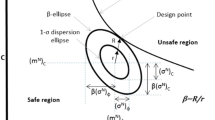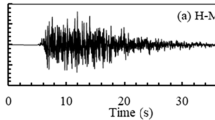Abstract
In this paper, by considering the upper-bound limit analysis method in calculating the seismic bearing capacity of foundations, the comparison between a limit equilibrium method such as Hansen and limit analysis method in terms of reliability is investigated. Limit equilibrium has been the oldest method for performing bearing capacity of foundations. However, it seems that theoretical equations proposed by the majority of old limit equilibrium methods to calculate the bearing capacity of foundations (such as Hansen) do not consider the effects of inertial forces of the earthquake in the soil mass. These methods only take into account the horizontal load applied to the foundation and disregard the earthquake forces applied to the soil. By comparing the results of this study, it can be inferred that the reliability of the Hansen approach is very close to the limit analysis method that ignores the impact of horizontal earthquake forces applied to rigid soil blocks. Since the upper-bound limit analysis takes into account the seismic effect of inertial forces in an earthquake, its results may be considered more accurate than Hansen. This study shows that in both granular and cohesive soils in high seismicity-prone areas, usage of a more realistic method as the limit analysis is more reasonable. Considering the facility of RBD by Hansen method using EXCEL spreadsheet in comparison to the seismic reliability-based design using MATLAB programming following the upper-bound limit analysis method, graphs that offer coefficients for obtaining the equivalent value of target reliability in the limit analysis by using the Hansen formulation are presented. Additionally, this study shows that the horizontal seismic coefficient (kh) is an impressive parameter that affects the differences between the two mentioned approaches.
















Similar content being viewed by others
References
Ang AH-S, Tang WH (1984) Probability concepts in engineering planning and design, vol. 2: Decision, risk, and reliability. Wiley, New York, p 608
Askari F, Farzaneh O (2003) Upper-bound solution for seismic bearing capacity of shallow foundations near slopes. Geotechnique 53(8):697–702
Chenari RJ, Roshandeh SP, Payan M (2019) Stochastic analysis of foundation immediate settlement on heterogeneous spatially random soil considering mechanical anisotropy. SN Appl Sci 1(7):660. https://doi.org/10.1007/s42452-019-0684-0
Cherubini C (2000) Reliability evaluation of shallow foundation bearing capacity on c’φ’soils. Can Geotech J 37(1):264–269
Choudhury D, Subba Rao KS (2006) Seismic bearing capacity of shallow strip footings embedded in slope. Int J Geomech 6(3):176–184
Fenton GA, Griffiths DV (2008) Risk assessment in geotechnical engineering, vol 461. Wiley, New York
Hasofer AM, Lind NC (1974) Exact and invariant second-moment code format. J Eng Mech Div 100(1):111–121
Hicks MA, Onisiphorou C (2005) Stochastic evaluation of static liquefaction in a predominantly dilative sand fill. Géotechnique 55(2):123–133
Liu H, Low BK (2018) Reliability-based design of tunnelling problems and insights for Eurocode 7. Comput Geotech 97:42–51
Low BK (1996) Practical probabilistic approach using spreadsheet. In: Uncertainty in the geologic environment: From theory to practice. ASCE, pp 1284–1302
Low BK (2007) Reliability-based design applied to retaining walls. In: Risk and Variability in Geotechnical Engineering. Thomas Telford Publishing, pp 151–163
Low BK (2017) Insights from reliability-based design to complement load and resistance factor design approach. J Geotech Geoenviron Eng 143(11):04017089
Low BK, Phoon K-K (2015) Reliability-based design and its complementary role to Eurocode 7 design approach. Comput Geotech 65:30–44
Low BK, Tang WH (1997) Reliability analysis of reinforced embankments on soft ground. Can Geotech J 34(5):672–685
Low BK, Tang WH (2004) Reliability analysis using object-oriented constrained optimization. Struct Saf 26(1):69–89
Melchers RE, Beck AT (2018) Structural reliability analysis and prediction. Wiley, New York
Mosallanezhad M, Moayedi H (2017) Comparison analysis of bearing capacity approaches for the strip footing on layered soils. Arab J Sci Eng 42(9):3711–3722
Nadi B, Askari F, Farzaneh O, Fatolahzadeh S, Mehdizadeh R (2019) Reliability evaluation of regression model for estimating Co-seismic landslide displacement. Iran J Sci Technol Trans Civ Eng 1:1–9
Onisiphorou C (2010) Reliability based assessment of rock slope stability. Rock Mech Civ Environ Eng-Proc Eur Rock Mech Symp 129(6):563–566
Phoon K-K (ed) (2014) Reliability-based design in geotechnical engineering: computations and applications. CRC Press, Boca Raton
Phoon K-K, Kulhawy FH (1999) Characterization of geotechnical variability. Can Geotech J 36(4):612–624
Rezaie Soufi G, Jamshidi Chenari R, Karimpour Fard M (2019) Influence of random heterogeneity of the friction angle on bearing capacity factor Nγ. Georisk: Assessm Manag Risk Eng Syst Geohazards 1:1–21. https://doi.org/10.1080/17499518.2019.1566554
Robert MAY (2015) The seismic design of shallow foundations: a state of the art exploration
Shakir RR (2019) Probabilistic-based analysis of a shallow square footing using Monte Carlo simulation. Eng Sci Technol Int J 22(1):313–333
Shojaeian A, Askari F (2019) Variables characteristics effects on static and pseudo-static reliability-based design of near slope shallow foundations. NMCE 3(3):1–12
Sloan S (2005) Geotechnical stability analysis: new methods for an old problem. Aust Geomech 40(30):1–28
Soubra A-H (1999) Upper-bound solutions for bearing capacity of foundations. J Geotech Geoenviron Eng 125(1):59–68
Viviescas JC, Osorio JP, Cañón JE (2017) Reliability-based designs procedure of earth retaining walls in geotechnical engineering. Obras y proyectos 22:50–60
Youssef Abdel Massih DS, Soubra A-H, Low BK (2008) Reliability-based analysis and design of strip footings against bearing capacity failure. J Geotech Geoenviron Eng 134(7):917–928
Author information
Authors and Affiliations
Corresponding author
Additional information
Publisher's Note
Springer Nature remains neutral with regard to jurisdictional claims in published maps and institutional affiliations.
Appendix
Appendix
In this appendix, exact formulations for computation of the parametric velocity related to rigid blocks, the geometry parameters of triangular blocks, and the procedure of calculating the bearing capacity is presented. Equations 4 and 5 represent the parametric velocity related to rigid block i, and Eq 6 shows the relative velocity between adjacent blocks(i and i + 1).
Equations 7–9 show the geometry parameters of triangular block i.
Now, according to the upper bound limit analysis theorem, the amount of bearing capacity can be determined by the equalization of internal and external works (Eqs. 14–16) introduced in Eqs. 10–13. The external work consists of the work of imposed load to the foundation (\(W_{P} )\), work of soil weight of the block i plus the work due to the inertial force acting on the block (\(W_{{w_{i} }}\)) and the surcharge work (\(W_{q}\)). Internal work includes the work dissipated in velocity discontinuities di and li (\(W_{{d_{i} }}\) and \(W_{{l_{i} }}\)). Energy is dissipated along the lines \(l_{i}\) (i = 1,…, n-1) and \(d_{i}\) (i = 1,…, n). Assuming the velocity of the first block, V1, equal to unity (δ = 1), the calculated load is the bearing capacity of the foundation.
\(W_{P}\): Work of imposed load to the foundation, \(W_{{w_{i} }}\): Work of soil weight of block I plus work due to inertial force acting on the block, \(W_{{d_{i} }}\): Work dissipated on velocity discontinuity \(d_{i}\), \(W_{{l_{i} }}\): Work dissipated on velocity discontinuity \(l_{i}\), C: Soil cohesion, \(\varphi\): Internal friction angle of the soil, \(\lambda_{i}\) :The angle between \(l_{i}\) and horizon, \(W_{q}\) :Surcharge work.
Rights and permissions
About this article
Cite this article
Shojaeian, A., Askari, F. Seismic Reliability Investigation of Bearing Capacity of Foundations Based on Limit Analysis and Limit Equilibrium Methods. Geotech Geol Eng 38, 6329–6342 (2020). https://doi.org/10.1007/s10706-020-01438-8
Received:
Accepted:
Published:
Issue Date:
DOI: https://doi.org/10.1007/s10706-020-01438-8




